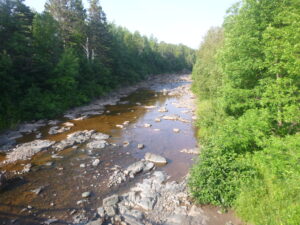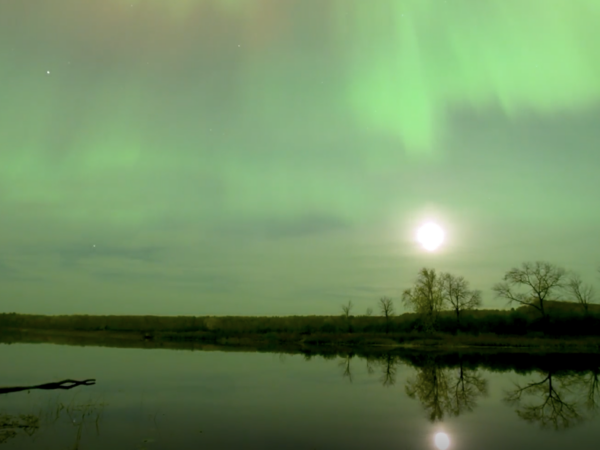
Editor’s Note: “Nibi Chronicles,” a monthly Great Lakes Now feature, is written by Staci Lola Drouillard. A direct descendant of the Grand Portage Band of Ojibwe, she lives and works in Grand Marais on Minnesota’s North Shore of Lake Superior. Her two books “Walking the Old Road: A People’s History of Chippewa City and the Grand Marais Anishinaabe” and “Seven Aunts” were published 2019 and 2022, and she is at work on a children’s story. “Nibi” is a word for water in Ojibwe, and these features explore the intersection of Indigenous history and culture in the modern-day Great Lakes region.
Raised on Saganagons Lake in the border country between the U.S. and Canada, Milt Powell was a great friend of the Drouillard family. He and my dad had many adventures as kids and young men, learning the way of the woods in far northeastern Minnesota.
I had the honor of interviewing Milt when I was conducting elder interviews for Walking the Old Road. He generously shared many stories about growing up on the Canadian side of Saganagons, and one of my favorite tales is about the Powell family’s pet beaver named Annabelle who lived inside and outside the house, just like any pet might do.
Milt told me that in the fall when the weather started to turn cold, Annabelle would frantically go around the cabin, gathering up stray socks, bits of ticking and whatever else she could find to stop the drafts from blowing through the gaps in the walls of their log cabin. She knew instinctively when it was time to button up for winter.
It’s not a coincidence that Algonquin-style lodges and beaver dams have a similar shape. The rounded domes help to keep the rain and snow from collecting on top of the shelter, and both types of housing are built with a hole at the top that opens to the sky.
For human inhabitants, the opening is there to allow smoke from the warming fire to escape. In a beaver dam, the breathing space at the top of the lodge brings a steady flow of oxygen into the house—creating a comfortable place for these water and land-based animals to stay warm and safe.
Busy as a …
A study by the University of Helsinki found that wherever they live, beavers help reduce flood intensity, filter water and capture greenhouse gases. The researchers describe beaver dams as “among the most biologically productive ecosystems in the world, comparable to coral reefs and rainforests.”
Classified as a North American “keystone” species, it’s remarkable that Annabelle and the rest of the border country beavers survived the Voyageurs and fur trade era that caused the near-extinction of her kind by 1900.
The fur trappers and traders used the chain of lakes and rivers along the border from Grand Portage to Saganaga Lake and beyond to transport mountains of beaver pelts out of the woods and onto the heads of wealthy Europeans. This led to an economic boon that is credited for driving the early, colonial economy, forging alliances between European traders and Indigenous tribes and instigating war over claims to beaver-trapping territory.
It proved to be unsustainable, and Amik the beaver, was nearly wiped out.

Knife River. (Photo Credit: Staci Lola Drouillard)
An uneven recovery
The Great Lakes beaver population has slowly recovered and today, you’ll find these prolific dam builders doing their work on waterways all across the region. But Amik is still under assault, and this time it’s because of the steelhead fishing industry which generates more than $7 billion annually in the Great Lakes region.
In the June 26th edition of the podcast Points North, my WTIP Radio colleague Joe Friedrichs reports on the Minnesota Department of Natural Resources’ plan to get rid of as many beavers and their dams as possible on the Knife and French Rivers, between Duluth and Two Harbors, Minnesota.
The DNR is in the business of hiring trappers to catch and kill beavers, on average removing 17 animals and at least 18 dams on the Knife River. Called beaver “management,” this state-funded agency uses dynamite to blow up dams, and of course, all beavers inside those dams, as well as otters and other collateral damage. I reached out to the 1854 Treaty Authority who confirmed that the Minnesota DNR did not collaborate with their agency on beaver removal.
Blowing up beaver dams isn’t just done in Minnesota, but also in Michigan and Wisconsin, where that state’s Wildlife Services department is being sued by Superior Bio-Conservancy, a Milwaukee-based nonprofit which claims that the Wisconsin DNR and Wildlife Services division is “destroying Wisconsin’s wetlands, weakening flood resiliency and exacerbating its biodiversity crisis. Through its beaver management program over the last decade, the division allegedly killed 28,141 beavers and destroyed 14,796 beaver dams through hand removal or explosives.”
It seems that Amik is still bearing the brunt of this brutally colonial way of doing business, pitting a keystone, native species against a non-native fish species like steelhead, which were introduced to the Great Lakes in the mid-1890s.
According to Karen Gran, a Minnesota Sea Grant/UMD researcher who studied the effects of beaver dams on the Knife and French Rivers in 2018 and 2019, the DNR’s actions might actually be making matters worse for steelhead and other trout, who spawn upriver every spring and need colder water temperatures and high-water flow for a successful class.
Monitoring water temperatures, fish movement and low-flow hydrology, the study found that having beaver dams upriver from trout spawning grounds helps keep the water cool downstream if the water flows beneath the surface of a beaver dam.
Only a very large dam has the potential to raise water temperatures, but the research group was not able to complete a long-term study on these larger dams, because the Minnesota DNR systematically destroyed them.
A separate study conducted by UMD that looked at water storage capacity over a span of 70 years on tributaries in the Lake Superior watershed (including the Knife River), confirms that over the course of time, beavers are the most efficient and effective water engineers when it comes to creating and maintaining water storage capacity and vibrant wetland ecosystems.

Beaver Dam on Saganaga Lake. (Photo Credit: Staci Lola Drouillard)
Amik, the giant beaver
There’s an old Ojibwe story about Amik—a giant beaver that once roamed the land, back when the trees were allowed to grow old and the waters were rich with name (nah-may–sturgeon) and namegos (nah-may-gos–trout).
After building a dam at the narrows between Lake Huron and Lake Superior, Amik’s human adversaries Nokomis and Weneboozhoo tried to force the beaver out of the narrows, which resulted in a mighty struggle that ended with Amik destroying its own lodge.
Mewizha—long time ago, the remnants of the giant dam became a maze of islands in the narrow channel between Lake Huron and Lake Superior. This chain of islands is now known as the Thirty Thousand Islands and ever since that time, human beings and Amik have agreed to be friends and coexist on the land, recognizing that we need each other.
Just like when Annabelle the beaver did her part to keep the cold winter winds from blowing through the Powell’s homestead on Saganagons Lake.
Catch more news at Great Lakes Now:
Nibi Chronicles: A portal to the Burt Lake Band’s violent expulsion
Nibi Chronicles: We are still here, and so is great grandma’s lilac
Featured image: Amik (beaver) courtesy of Ryan Blaisdell. (Photo Credit: Staci Lola Drouillard)
1 Comment
-
I really enjoyed this article and am hopeful that the dnr can ;earn from the research and neighboring states how much beaver mean to healthy trout populations. One correction. beavers do not live in the dam. That is where they “work”.




